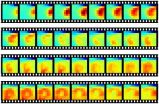(Press-News.org) This news release is available in German.
When we drift into deep slow-wave sleep (SWS), waves of neuronal activity wash across our neocortex. Birds also engage in SWS, but they lack this particular brain structure. Researchers from the Max Planck Institute for Ornithology in Seewiesen, Germany together with colleagues from the Netherlands and Australia have gained deeper insight into the sleeping avian brain. They found complex 3D plumes of brain activity propagating through the brain that clearly differed from the two-dimensional activity found in mammals. These findings show that the layered neuronal organization of the neocortex is not required for waves to propagate, and raise the intriguing possibility that the 3D plumes of activity perform computations not found in mammals.
Mammals, including humans, depend upon the processing power of the neocortex to solve complex cognitive tasks. This part of the brain also plays an important role in sleep. During SWS, slow neuronal oscillations propagate across the neocortex as a traveling wave, much like sports fans performing the wave in a stadium. It is thought that this wave might be involved in coordinating the processing of information in distant brain regions. Birds have mammalian-like cognitive abilities, but yet different neuronal organization. They lack the elegant layered arrangement of neurons characteristic of the neocortex. Instead, homologous neurons are packaged in unlayered, seemingly poorly structured nuclear masses of neurons.
Researchers from the Max Planck Institute for Ornithology in Seewiesen together with colleagues from the Netherlands and Australia now investigated in female zebra finches how brain activity changed over space and time during sleep. "When we first looked at the recordings, it appeared that the slow waves were occurring simultaneously in all recording sites.
However, when we visualized the data as a movie and slowed it down, a fascinating picture emerged!" says Gabriël Beckers from Utrecht University, who developed the high-resolution recording method at the Max Planck Institute for Ornithology in Seewiesen. The waves were moving across the two-dimensional recording array as rapidly changing arcs of activity. Rotating the orientation of the array by 90 degrees revealed similar patterns, and thereby established the 3D nature of the plumes propagating through the brain. The researchers found similar patterns in distant brain regions involved in processing different types of information, suggesting that this type of activity is a general feature of the sleeping avian brain.
In addition to revealing how neurons in the avian brain behave during sleep, this research also adds to our understanding of the sleeping neocortex. "Our findings demonstrate that the traveling nature of slow waves is not dependent upon the layered organization of neurons found in the neocortex, and is unlikely to be involved in functions unique to this pattern of neuronal organization," says Niels Rattenborg, head of the Avian Sleep Group in Seewiesen. "In this respect, research on birds refines our understanding of what is and is not special about the neocortex." Finally, the researchers wonder whether the 3D geometry of wave propagation in the avian brain reflects computational properties not found in the neocortex. While this idea is clearly speculative, the authors note that during the course of evolution, birds replaced the three-layered cortex present in their reptilian ancestors with nuclear brain structures. "Presumably, there are benefits to the seemingly disorganized, nuclear arrangement of neurons in the avian brain that we are far from understanding. Whether this relates to what we have observed in the sleeping bird brain is a wide open question," says Rattenborg.
INFORMATION:
Original work:
Beckers GJL, van der Meij J, Lesku JA, Rattenborg NC. Plumes of neuronal activity propagate in three dimensions through the nuclear avian brain. BMC Biology, published online Feb. 28, 2014.
Plumes in the sleeping avian brain
Brain activity during slow-wave-sleep differs between mammals and birds
2014-03-05
ELSE PRESS RELEASES FROM THIS DATE:
New technique allows frequent water quality monitoring for suite of pollutants
2014-03-05
Researchers from North Carolina State University have developed a new technique that uses existing technology to allow researchers and natural resource managers to collect significantly more information on water quality to better inform policy decisions.
"Right now, incomplete or infrequent water quality data can give people an inaccurate picture of what's happening – and making decisions based on inaccurate data can be risky," says Dr. François Birgand, an assistant professor of biological and agricultural engineering at NC State and co-author of a paper describing the ...
Copied from nature: Detecting software errors via genetic algorithms
2014-03-05
This news release is available in German.
According to a current study from the University of Cambridge, software developers are spending about the half of their time on detecting errors and resolving them. Projected onto the global software industry, according to the study, this would amount to a bill of about 312 billion US dollars every year. "Of course, automated testing is cheaper", explains Andreas Zeller, professor of Software Engineering at Saarland University, as you could run a program a thousand times without incurring any charges. "But where do these ...
New findings on neurogenesis in the spinal cord
2014-03-05
Research from Karolinska Institutet in Sweden suggests that the expression of the so called MYC gene is important and necessary for neurogenesis in the spinal cord. The findings are being published in the journal EMBO Reports.
The MYC gene encodes the protein with the same name, and has an important role in many cellular processes such as proliferation, metabolism, cell death and the potential of differentiation from immature stem cell s to different types of specialized cells . Importantly it is also one of the most frequently activated genes in human cancer.
Previously ...
Barbie could dampen a young girl's career dreams
2014-03-05
Although the marketing slogan suggests that Barbie can "Be Anything," girls who play with this extremely popular doll see fewer career options available to themselves compared to boys. So say Aurora Sherman of Oregon State University and Eileen Zurbriggen of the University of California, Santa Cruz, who conducted one of the first experiments on how playing with fashion dolls influences girls' perceptions about their future occupational options. The findings, which the psychologists describe as "sobering," are published in Springer's journal Sex Roles.
Sherman and Zurbriggen ...
Technique patented that opens the door to the development of new drugs against osteoporosis
2014-03-05
This news release is available in Spanish.
Scientists from the University of Granada (UGR) have opened the door to the development of new drugs against osteoporosis, one of the most common chronic illnesses in the world, especially among women 65 or over.
The researchers, from the University of Granada's Department of Physio-Chemistry, have patented a new methodology that allows specialists to measure – none-invasively and in real time – the concentration of phosphate ions inside living cells. The scientific importance of measuring phosphate ions is based precisely ...
Banana plant fights off crop's invisible nemesis: Roundworms
2014-03-05
The banana variety Yangambi km5 produces toxic substances that kill the nematode Radopholus similis, a roundworm that infects the root tissue of banana plants – to the frustration of farmers worldwide. The finding bodes well for the Grande Naine, the export banana par excellence, which is very susceptible to the roundworms.
The parasitic nematode Radopholus similis is the invisible nemesis of the banana plant, says Professor Dirk De Waele (Laboratory for Tropical Crop Improvement, KU Leuven), a co-author of the study: "This roundworm infects banana crops worldwide. The ...
Patients' stories used to improve care on wards
2014-03-05
A research project led by Oxford University is showing how patient experiences can be used to improve healthcare – not through targets and surveys, but by getting doctors, nurses and patients talking together about care on the ward.
The new approach has been used in pilot projects at two UK hospital trusts – Royal Brompton & Harefield NHS Foundation Trust in London and the Royal Berkshire in Reading. Videos of patients talking about care they received at various hospitals are used to trigger a discussion between NHS staff, managers, patients and family members about the ...
Program to move families out of high-poverty neighborhoods has mixed results
2014-03-05
A program designed to move families out of high-poverty neighborhoods resulted in reduced rates of depression and conduct disorder among girls, but increased rates of depression, post-traumatic stress disorder (PTSD) and conduct disorder among boys, according to a study published in the March 5 issue of JAMA.
Prof. Jens Ludwig, one of the study's authors, said this was a follow-up long-term analysis of families participating in the Moving to Opportunity residential-mobility demonstration sponsored by the U.S. Department of Housing and Urban Development. Ludwig is the ...
NASA's Hubble finds life is too fast, too furious for this runaway galaxy
2014-03-05
The spiral galaxy ESO 137-001 looks like a dandelion caught in a breeze in this new Hubble Space Telescope image.
The galaxy is zooming toward the upper right of this image, in between other galaxies in the Norma cluster located over 200 million light-years away. The road is harsh: intergalactic gas in the Norma cluster is sparse, but so hot at 180 million degrees Fahrenheit that it glows in X-rays.
The spiral plows through the seething intra-cluster gas so rapidly – at nearly 4.5 million miles per hour — that much of its own gas is caught and torn away. Astronomers ...
UW researchers use Lumosity to identify early cognitive impairment in cirrhosis patients
2014-03-05
San Francisco, Calif. – March 5, 2014 – A new study from the University of Washington has found that performance on Lumosity games can distinguish between patients with cirrhosis of the liver, pre-cirrhotic patients, and healthy controls. The study used Lumosity games as psychometric tests to detect subtle cognitive impairments in patients with cirrhosis. The study is published in the March issue of the American Journal of Gastroenterology.
Studies have found that an estimated 60-80 percent of cirrhosis patients experience cognitive dysfunction, which can range from ...
LAST 30 PRESS RELEASES:
Making lighter work of calculating fluid and heat flow
Normalizing blood sugar can halve heart attack risk
Lowering blood sugar cuts heart attack risk in people with prediabetes
Study links genetic variants to risk of blinding eye disease in premature infants
Non-opioid ‘pain sponge’ therapy halts cartilage degeneration and relieves chronic pain
AI can pick up cultural values by mimicking how kids learn
China’s ecological redlines offer fast track to 30 x 30 global conservation goal
Invisible indoor threats: emerging household contaminants and their growing risks to human health
Adding antibody treatment to chemo boosts outcomes for children with rare cancer
Germline pathogenic variants among women without a history of breast cancer
Tanning beds triple melanoma risk, potentially causing broad DNA damage
Unique bond identified as key to viral infection speed
Indoor tanning makes youthful skin much older on a genetic level
Mouse model sheds new light on the causes and potential solutions to human GI problems linked to muscular dystrophy
The Journal of Nuclear Medicine ahead-of-print tip sheet: December 12, 2025
Smarter tools for peering into the microscopic world
Applications open for funding to conduct research in the Kinsey Institute archives
Global measure underestimates the severity of food insecurity
Child survivors of critical illness are missing out on timely follow up care
Risk-based vs annual breast cancer screening / the WISDOM randomized clinical trial
University of Toronto launches Electric Vehicle Innovation Ontario to accelerate advanced EV technologies and build Canada’s innovation advantage
Early relapse predicts poor outcomes in aggressive blood cancer
American College of Lifestyle Medicine applauds two CMS models aligned with lifestyle medicine practice and reimbursement
Clinical trial finds cannabis use not a barrier to quitting nicotine vaping
Supplemental nutrition assistance program policies and food insecurity
Switching immune cells to “night mode” could limit damage after a heart attack, study suggests
URI-based Global RIghts Project report spotlights continued troubling trends in worldwide inhumane treatment
Neutrophils are less aggressive at night, explaining why nighttime heart attacks cause less damage than daytime events
Menopausal hormone therapy may not pose breast cancer risk for women with BRCA mutations
Mobile health tool may improve quality of life for adolescent and young adult breast cancer survivors
[Press-News.org] Plumes in the sleeping avian brainBrain activity during slow-wave-sleep differs between mammals and birds







